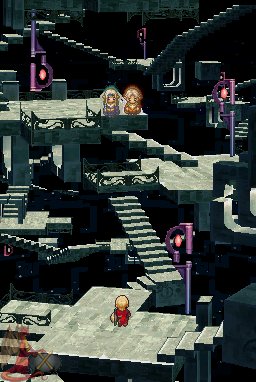|
|

|
PLATFORM
|
DS
|
BATTLE SYSTEM
|

|
INTERACTION
|

|
ORIGINALITY
|

|
STORY
|

|
MUSIC & SOUND
|

|
VISUALS
|

|
CHALLENGE
|
Easy
|
COMPLETION TIME
|
20-40 Hours
|
|
OVERALL

|
+ Terrific, engaging battle system.
+ Excellent visual design.
+ Wonderful story told in a unique way.
+ Great soundtrack.
- Slow-paced.
- Surprisingly linear.
|
Click here for scoring definitions
|
|
|
Truthfully, I had no idea what, precisely, to expect when I loaded up Radiant Historia. The game's pedigree and potential inspiration come from so many different sources that it was hard to guess what the title had in store. It was revealed early on that the game was being built with staff who worked on Radiata Stories and the Shin Megami Tensei series, and there was a time-travel story possibly in the vein of Chrono Trigger. As it turns out, Radiant Historia is completely unlike any of those games. It's its own animal, a unique breed that bears no real resemblance to anything else, and that is probably its greatest strength.
Radiant Historia follows the adventures of Stocke, a reserved but highly skilled intelligence agent for the Alistel military. Alistel is at war with its neighbour Granorg to the west, and as the fighting increases, Stocke is sent out on an important mission. Before leaving, he is gifted with a mysterious book known as the White Chronicle by his commander. When the mission goes horribly wrong and Stocke is wounded and left for dead, he finds himself transported to the mysterious world of Historia, which governs over time itself. There he meets a pair of children who warn him of an impending catastrophe that will reduce the entire world to a single, vast desert. Unless, of course, Stocke can navigate the annals of history and find the one true path that will lead to the world's salvation.
Politically charged, teeming with intrigue, and filled to the brim with complex and interesting characters, Radiant Historia sets itself apart, not only thanks to its fantastic plot, but also how the tale is told. After the first initial instance of time travel, Radiant Historia's plot branches into two independent timelines. Each plays out separately, but also interacts with the other in various ways, so that one must play through both simultaneously in order to advance. If Stocke reaches a deadlock in one timeline, the way forward is likely hidden in the other. The methods of breaking these deadlocks vary from learning a new skill to altering characters' decisions by talking to them in another timeline. Even more intriguing, as the story progresses, every part of the tale appears as a node in the White Chronicle. Stocke can then use the book to travel back to certain nodes whenever he wants, which essentially creates a never-ending new game plus mode that can be accessed at any time. Many side quests as well as several main quests take advantage of this feature, and to complete them Stocke will have to strategically jump from node to node to find what he needs.
 Who knew that time was really an Escher painting.
Who knew that time was really an Escher painting.
|
|
That said, Radiant Historia is also surprisingly linear for a game about time travel. Despite there being two timelines, there's really only a single path through the story. Occasionally players will find themselves faced with "important" decisions, but these choices will result in either progressing forward or an early game-over, forcing you to choose the other, correct option. However, there's still a lot of leeway in the order one moves through various events, and the time-travel mechanics are used regularly, even if actual player choice is ultimately limited.
While it's rare enough for a game's story to be a core part of the actual gameplay, Radiant Historia doesn't shirk in other, more traditional areas. The combat system is refreshing and unique, exactly the sort of thing you'd expect from the fine folks who made Shin Megami Tensei. When a battle begins, the player's three characters are lined up to the right while the enemies are placed on a three by three grid on the left, each taking up a different amount of squares depending on their physical size. Combat in Radiant Historia then relies on two distinct strategies: manipulating the turn order, and manipulating enemy positions on the grid.
To start with, character or enemy attacks are performed at once with the rest of their team, so long as their turns are adjacent to each other. Although enemies can't manipulate the turn order, player characters all have the "Change" ability at their disposal, which allows the player the alter the order in which attacks take place. Characters can deal additional damage by building up attack combos, but the combo meter resets to zero when an enemy takes its turn, which means it's well worth the effort to ensure that player turns coincide with each other. The "Change" command is a double-edged sword, however, as that character will also receive additional damage until they ultimately take their turn.
Adjusting the turn order has other benefits to it, which plays into the second aspect of combat: manipulating enemy positions on the grid. All characters learn skills (though which ones they learn varies from character to character) that can push an enemy left or right, forward or backward. Enemies do less damage when they attack from the back row, and players can do more damage to enemies in the front row, so this already has some basic benefits. More importantly, if an enemy is knocked into another enemy, until the current combo ends, those enemies will now occupy the same square. When one of them is attacked, they're both attacked. Pushing them again can add more enemies into the pile, allowing players to damage multiple enemies at once. By changing the turn order and knocking enemies around, players can make every attack count and win battles much quicker.
 With pick up lines like that, it's no wonder Stocke gets all the ladies.
With pick up lines like that, it's no wonder Stocke gets all the ladies.
|
|
Radiant Historia's combat system is almost as impressive as its story. The skills each of the various characters learn are extremely well thought out and can lead to some really neat strategies. In fact, strategies will vary drastically based on which characters are in the player's party, and that's a pretty rare thing for a JRPG. Early on, character selection is fairly limited, but as the game progresses, players can shape their party however they choose. Unfortunately, the system is also fairly slow-paced. Though turns go by at a lightning-fast pace, encounters are set up so that even normal ones take several rounds to complete. As the game progresses, methods become available that make it easier to avoid getting into needless battles, but it does hurt the pacing of the game quite regularly.
The visual design of Radiant Historia is a real treat and rather unorthodox. The game features full 3D environments, making use of a straight-forward camera view rather than the typical isometric view seen in other 2.5D RPGs. Characters are displayed as detailed sprites, and move around in the 3D environments quite naturally. More impressive, however, are the character designs themselves. Making use of an ornate, almost gothic art style, they're quite different from typical anime characters, and much more complex in design. The entire game makes use of a fairly soft color palette, which helps it stand apart from its peers. The soundtrack, composed by Yoko Shimomura, is equally delightful. Best known by RPGamers for her work on the Kingdom Hearts series, the score maintains her signature use of strings and woodwinds, but also features a great deal of terrific piano work.
Although the game can move at a fairly slow pace, the terrific battle system and well-told story make Radiant Historia one of the better adventures on the Nintendo DS. The time-traveling nature of the game, which allows you play and replay various sections at a whim, makes it easy to pick up again after extended periods away, solidifying it as an excellent travel companion. Players can expect to put close to forty hours into the game, more should they take the time to complete all the sidequests. A unique, lengthy adventure, Radiant Historia is unlike most other RPGs on the DS and is definitely worth checking out.
Review Archives
|









